
Category: GARMENTS
Country: Vietnam
Region: Asia Pacific
By Nguyen Vy
13th October, 2024 | 09:30
Vietnam's textile and garment industry is witnessing an impressive growth period, with export turnover increasing steadily in recent months.
-Textile and garment exports: Mixed advantages and difficulties
-More than 37 billion USD of FDI capital flows into the textile and garment industry: What to do to take advantage of it effectively?
-Taking advantage of EVFTA to boost Vietnamese exports to the Nordic market
According to statistics from the General Department of Customs, textile and garment exports in September 2024 increased by 15.8% compared to September 2023, reaching nearly 2.98 billion USD. In the first 9 months of 2024, the total turnover reached over 27.34 billion USD, an increase of 8.9% compared to the first 9 months of 2023.
Vietnam currently exports textiles and garments to 113 countries and territories. Of which, Vietnam's textile and garment exports to the US continue to rank first in terms of turnover, reaching nearly 12.01 billion USD, accounting for 43.9% of the country's total textile and garment export turnover, up 9.1% compared to the first 9 months of 2023; September 2024 alone reached 1.22 billion USD, up 20.4% compared to September 2023.
Exports to Japan ranked second in turnover, reaching 3.13 billion USD, accounting for 11.4%, up 6.4%; in September 2024 alone, turnover increased by 5% compared to September 2023.
Next is the Korean market reaching 2.38 billion USD, accounting for 8.7%, down slightly by 1.8% and to China reaching 978.17 million USD, accounting for 3.6%, up 18.3% compared to the first 9 months of 2023.
Notably, Russia is one of the countries that has increased the import of this item from Vietnam. Specifically, in September, Vietnam exported nearly 71 million USD worth of textile and garment products to Russia, an increase of 97.6% over the same period.
In the first 9 months, Vietnam earned 616.3 million USD from textile and garment exports to the Russian market, a sharp increase of 118% compared to the first 9 months of 2023. This market accounts for 2.25% of Vietnam's total textile and garment export turnover and is in the top 10 largest export markets.
As one of the three largest textile and garment exporters in the world, employing more than 2 million workers and with monthly export turnover reaching from 3.5 to 4 billion USD, the Vietnamese textile and garment industry is taking full advantage of opportunities opened up by fluctuations in the global market.
In addition, in the context of developments in Bangladesh, the Vietnam Textile and Apparel Association (VITAS) stated that “in the short term, the Vietnamese textile and garment industry will have some advantages when Bangladesh’s textile and garment production capacity decreases during the peak season of winter production; many customers will have to shift their orders to other countries to make up for the shortage .”
The instability in Bangladesh, a major competitor, has created opportunities for Vietnamese businesses to access more orders. Customers are looking for reliable alternative sources of supply, and Vietnam, with its abundant production capacity and increasingly improved product quality, is becoming an attractive option.
The trend of consuming sustainable products is increasing globally. Vietnam, with its efforts in building sustainable supply chains and meeting international standards, is attracting the attention of major retailers.
In addition, Vietnamese enterprises are constantly diversifying export markets, minimizing risks and enhancing competitiveness. Markets such as the US, Japan, South Korea and China are still the main markets, but emerging markets are also being exploited.
According to cyclical factors, demand for goods often increases sharply in the last months of the year. This is a great opportunity when Vietnam's main export markets such as the US, Japan, South Korea, and China all increase, while Europe has the lowest growth rate, only 0.8%.
However, the Vietnamese textile and garment industry still faces internal challenges such as limited dyeing and weaving capacity, affecting the ability to expand exports. To overcome challenges and seize opportunities, Vietnamese textile and garment enterprises need to proactively invest in technology, innovate products, and improve product quality to meet increasingly high market demands. Currently, textile and garment exporting enterprises are focusing on solutions such as investing in technology and optimizing production processes, deeply participating in the OBM and ODM value chain, increasing production thanks to abundant imported raw materials, etc.
In addition, textile and garment enterprises focus on training and improving skills for workers, building a highly qualified workforce. They focus on developing sustainable supply chains, protecting the environment and ensuring worker welfare.
According to Mr. Vu Duc Giang, Chairman of VITAS, “ The increase in orders is not due to increased market demand, but mainly due to the shift from other countries to Vietnam. Thus, with the focus on investment in technology development, green and sustainable production such as using renewable energy, reducing emissions from domestic enterprises, the textile and garment industry has had many remarkable growths .”
With continuous efforts, the Vietnamese textile and garment industry is expected to continue to maintain its growth momentum in the coming time. The export turnover target of 44 billion USD (up 9.2% compared to 2023) in 2024 is considered completely feasible. However, to achieve this goal, businesses need to proactively adapt to market fluctuations and seize new opportunities.
Courtesy: Giaothuong.congthuong.vn
Copyrights © 2025 GLOBAL TEXTILE SOURCE. All rights reserved.